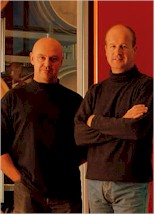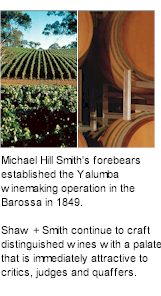


Shaw + Smith's aim is to make contemporary, high quality wines that stand amongst the best of their type, both nationally and internationally. For a wine to be released under the Shaw + Smith label it must be an oustanding example of it's type, from grapes grown in the Adelaide Hills. For the first ten years Shaw + Smith focussed on Sauvignon Blanc and Chardonnay, and now also make small quantities of Riesling, Pinot Noir and Shiraz. White varieties are well suited to the cooler climate of the Adelaide Hills, while Pinot Noir and Shiraz perform well in carefully chosen sites.

Martin Shaw is a winemaker with considerable international experience. He graduated from the Roseworthy College in 1981 and worked with Brian Croser at Petaluma for eight years prior to setting up the 'Flying Winemakers' network in France, Spain, Chile, Australia and New Zealand. In addition to Shaw + Smith, Martin still consults at number of companies within Australia and overseas. Aside from being a wine producer, Michael Hill Smith is a wine judge and consultant and contributes to various wine and food publications. In 1988, Hill Smith became the first Australian to pass the rigorous Master of Wine examination in London.
The Adelaide Hills is one of the most exciting wine regions. Although grapes were planted as early as 1839, it was not until the early 1980's that modern viticulture emerged. Today there are 54 Adelaide Hills wine labels with over 3000 ha of vineyard planted and more planned for the future. The region is strikingly beautiful with its patchwork of forests, farms, orchards and vineyards.
Because of it's distinctive cool climate, the grapes grown in the Hills have wonderful fruit composition, particularly in depth and spectrum of flavour, natural acid balance and overall finesse. Grape varieties best suited to the Adelaide Hills are Sauvignon Blanc, Chardonnay, Riesling, Merlot and Pinot Noir. Cabernet Sauvignon and Shiraz are more marginal, but perform well on certain sites with some experimentation with Viognier, Nebbiolo and Tempranillo.

In 1994 Shaw + Smith planted 28-ha of vines at Woodside in the Adelaide Hills. This vineyard is the home of Shaw and Smith's single vineyard M3 Chardonnay and consistently produces outstanding chardonnay fruit. The balance of the vineyard is planted to sauvignon blanc and is a vital component of the estate Sauvignon Blanc blend each year. The M3 Vineyard is close planted and uses vertical shoot positioning, the canopy configuration that has been so successful in the region. The soil is sandy loam over red-yellow clay with some shale.
In September 1999 Shaw + Smith purchased 46 ha on Jones Road between Balhannah and Hahndorf. The property is blessed with wonderful views of Mt Lofty, is ideally suited to viticulture and was planted to Sauvignon Blanc, Shiraz, Pinot Noir and Riesling. Average altitude 420 metres and all grapes are hand picked. The soil is free draining sandy loam over red clay with underlying quartzite and shale. As well as being home for the winery, the Balhannah property is the site of the single vineyard Riesling and Pinot Noir wines and contributes to the fruit sourced for the Sauvignon Blanc. Just behind the winery, on a prized northerly aspect, a parcel has recently been planted to Shiraz. The soil is sandy loam over red clay with underlying quartzite and shale.
A new winery was built for vintage 2000, which houses Shaw + Smith's production, marketing and administration. A new bottling line was installed in 2002, ensuring full control of every aspect of production, from grape berry to bottle. The winery design was a collaboration between Asbroek Engineering, JBG Architects and Christopher Connell Design. The winery has a wonderful contemporary feel throughout with tasting room and facilities.
